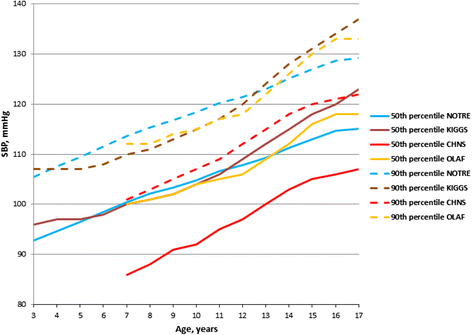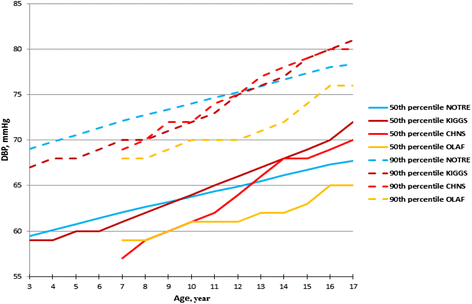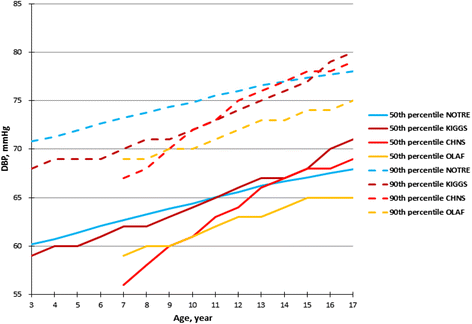Oscillometric blood pressure by age and height for non overweight children and adolescents in Lubumbashi, Democratic Republic of Congo
- PMID: 29351738
- PMCID: PMC5775618
- DOI: 10.1186/s12872-018-0741-4
Oscillometric blood pressure by age and height for non overweight children and adolescents in Lubumbashi, Democratic Republic of Congo
Abstract
Background: The diagnosis of hypertension in children is complex because based on normative values by sex, age and height, and these values vary depending on the environment. Available BP references used, because of the absence of local data, do not correspond to our pediatric population. Accordingly, our study aimed to provide the BP threshold for children and adolescents in Lubumbashi (DRC) and to compare them with German (KIGGS study), Polish (OLAF study) and Chinese (CHNS study) references.
Methods: We conducted a cross-sectional study among 7523 school-children aged 3 to 17 years. The standardized BP measurements were obtained using a validated oscillometric device (Datascope Accutor Plus). After excluding overweight and obese subjects according to the IOTF definition (n = 640), gender-specific SBP and DBP percentiles, which simultaneously accounted for age and height by using an extension of the LMS method, namely GAMLSS, were tabulated.
Results: The 50th, 90th and 95th percentiles of SBP and DBP for 3373 boys and 3510 girls were tabulated simultaneously by age and height (5th, 25th, 50th, 75th and 95th height percentile). Before 13 years the 50th and 90th percentiles of SBP for boys were higher compared with those of KIGGS and OLAF, and after they became lower: the difference for adolescents aged 17 years was respectively 8 mmHg (KIGGS) and 4 mmHg (OLAF). Concerning girls, the SBP 50th percentile was close to that of OLAF and KIGGS studies with differences that did not exceed 3 mmHg; whereas the 90th percentile of girls at different ages was high. Our oscillometric 50th and 90th percentiles of SBP and DBP were very high compared to referential ausculatory percentiles of the CHNS study respectively for boys from 8 to 14 mmHg and 7 to 13 mmHg; and for girls from 10 to 16 mmHg and 11 to 16 mmHg.
Conclusions: The proposed BP thresholds percentiles enable early detection and treatment of children and adolescents with high BP and develop a local program of health promotion in schools and family.
Keywords: Adolescents; Blood pressure; Children; GMLSS; LMS; Lubumbashi; Percentile tables.
Conflict of interest statement
Ethics approval and consent to participate
The approval to conduct the study and authorizations were obtained from the Medical Ethic Committee of the University of Lubumbashi (UNILU/CEM/027/2013–27 september 2013), the Provincial Ministry of Education, Scientific Research, Transport and Energy of Katanga (N° 10.5/0209/CAB/MIN.PROV/ED.R.TE/KAT/2014–11 march 2014) and the authorities of the selected schools. Data was used with high confidentiality and no names were recorded. The informed written consent to participate was obtained from the parent/guardians of the child or adolescent.
Consent for publication
The informed written consent to participate and for the publication of individual clinical details was obtained from the parent/guardians of the child or adolescent.
Competing interests
The authors declare that they have no competing interests.
Publisher’s Note
Springer Nature remains neutral with regard to jurisdictional claims in published maps and institutional affiliations.
Figures




Similar articles
-
Preschool children blood pressure percentiles by age and height.J Hum Hypertens. 2017 Jun;31(6):400-408. doi: 10.1038/jhh.2016.90. Epub 2016 Dec 29. J Hum Hypertens. 2017. PMID: 28032626
-
Oscillometric blood pressure percentiles for Polish normal-weight school-aged children and adolescents.J Hypertens. 2012 Oct;30(10):1942-54. doi: 10.1097/HJH.0b013e328356abad. J Hypertens. 2012. PMID: 22828086
-
Blood pressure percentiles by age and height for children and adolescents in Tehran, Iran.J Hum Hypertens. 2016 Apr;30(4):268-77. doi: 10.1038/jhh.2015.52. Epub 2015 May 28. J Hum Hypertens. 2016. PMID: 26016596
-
How to Apply European and American Guidelines on High Blood Pressure in Children and Adolescents. A Position Paper Endorsed by the Italian Society of Hypertension and the Italian Society of Pediatrics.High Blood Press Cardiovasc Prev. 2020 Jun;27(3):183-193. doi: 10.1007/s40292-020-00369-y. Epub 2020 Mar 13. High Blood Press Cardiovasc Prev. 2020. PMID: 32170711 Review.
-
Performance of blood pressure-to-height ratio as a screening tool for elevated blood pressure in pediatric population: a systematic meta-analysis.J Hum Hypertens. 2016 Nov;30(11):697-702. doi: 10.1038/jhh.2016.12. Epub 2016 Mar 3. J Hum Hypertens. 2016. PMID: 26935285 Review.
Cited by
-
Age-, sex-, and height-based blood pressure reference charts, Yazd children 6-18 years, Iran.Clin Exp Pediatr. 2020 Aug;63(8):321-328. doi: 10.3345/cep.2019.00094. Epub 2020 Jul 21. Clin Exp Pediatr. 2020. PMID: 32689764 Free PMC article.
-
Paediatric Hypertension in Africa: A Systematic Review and Meta-Analysis.EClinicalMedicine. 2021 Dec 6;43:101229. doi: 10.1016/j.eclinm.2021.101229. eCollection 2022 Jan. EClinicalMedicine. 2021. PMID: 34917909 Free PMC article.
-
Longitudinal associations between early-life fluoride exposures and cardiometabolic outcomes in school-aged children.Environ Int. 2024 Jan;183:108375. doi: 10.1016/j.envint.2023.108375. Epub 2023 Dec 13. Environ Int. 2024. PMID: 38128386 Free PMC article.
-
Comparison of China Reference with Different National and International References: The Prevalence of High Blood Pressure in 695,302 Children and Adolescents in a Metropolis of Yangtze River Delta, China.Int J Hypertens. 2021 Nov 9;2021:3976609. doi: 10.1155/2021/3976609. eCollection 2021. Int J Hypertens. 2021. PMID: 34796027 Free PMC article.
-
Age-based centiles for diastolic blood pressure among children in the out-of-hospital emergency setting.J Am Coll Emerg Physicians Open. 2023 Feb 25;4(2):e12915. doi: 10.1002/emp2.12915. eCollection 2023 Apr. J Am Coll Emerg Physicians Open. 2023. PMID: 36852188 Free PMC article.
References
Publication types
MeSH terms
LinkOut - more resources
Full Text Sources
Other Literature Sources
Medical

